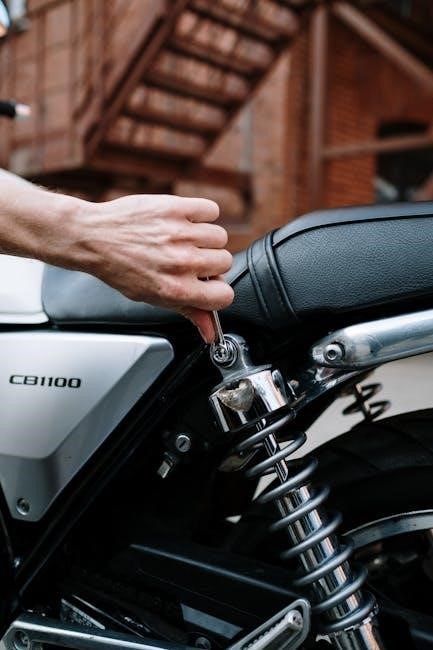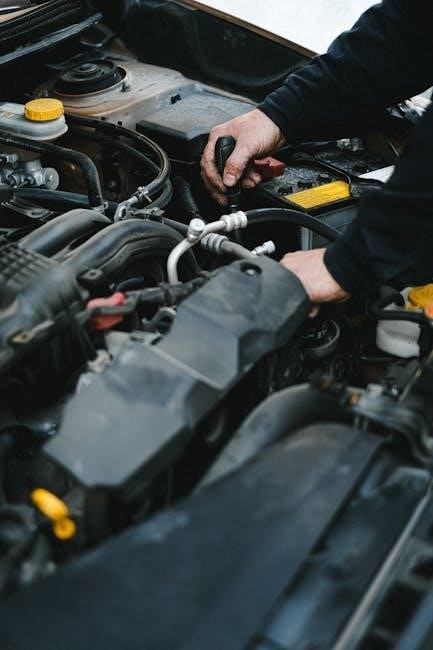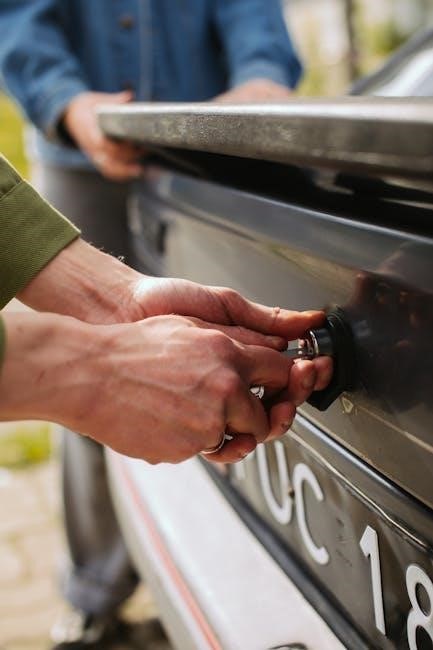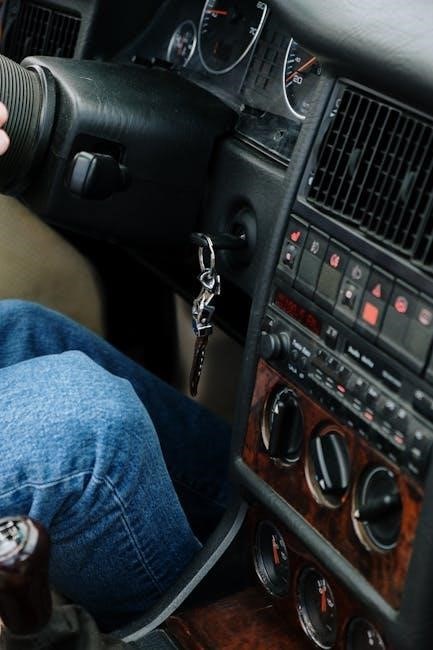A Vehicle Blackbox DVR is a dual-lens rearview mirror dash cam, offering Ultra HD recording, loop recording, and night vision. It ensures clear footage capture, enhancing road safety and evidence collection.

Key Features and Specifications
The Vehicle Blackbox DVR features dual lenses, Ultra HD recording, a 4.3-inch display, and loop recording. It supports night vision, WiFi connectivity, and captures clear 1080P Full HD videos with 12MP resolution.
2.1 Dual Camera Setup
The Vehicle Blackbox DVR features a dual-camera setup, designed to capture footage from both the front and rear of your vehicle. This setup ensures comprehensive coverage, providing clear video evidence in case of an accident or incident. The dual lenses work simultaneously, recording high-quality video and images, which can be crucial for insurance purposes or legal documentation. The front camera typically captures the road ahead, while the rear camera monitors the interior or the rear window, offering a dual perspective for enhanced safety. Both cameras are equipped with night vision capabilities, ensuring clarity even in low-light conditions. The dual-camera setup is a standout feature, making the DVR a reliable choice for drivers seeking robust surveillance and peace of mind on the road.
2.2 Display Specifications
The Vehicle Blackbox DVR boasts a high-quality 4.3-inch display, designed for clear and crisp video playback. With Ultra HD resolution, the screen delivers vibrant visuals, making it easy to review recorded footage or monitor real-time video. The display features a 2-in-1 TFT screen, combining functionality and durability. It supports touch functionality, allowing users to navigate menus and adjust settings with ease. The screen is also equipped with night vision compatibility, ensuring visibility even in low-light conditions. Additionally, the display can be adjusted for brightness, contrast, and color balance to suit different lighting environments. The compact size of the screen makes it an ideal fit for rearview mirrors, maintaining a seamless and non-obstructive design. Overall, the display is a critical component of the DVR, enhancing user experience and ensuring optimal performance for both recording and playback purposes.

Installation and Setup
Mount the DVR securely, connect power, and enable WiFi. Ensure the device is properly aligned and functioning. Follow manual instructions for a seamless setup experience.
3.1 Hardwiring the Device
Hardwiring your Vehicle Blackbox DVR ensures continuous power supply and automatic start-up. Locate your car’s fuse box and identify the ignition and constant power wires. Connect the DVR’s power cable to these wires, ensuring secure connections. Use a voltage multimeter to verify live wires before connecting. Mount the device firmly and route cables neatly to avoid obstructions. If unsure, consult a professional or refer to your vehicle’s wiring diagram for precise connections. Proper hardwiring ensures reliable performance and prevents battery drain. Always follow safety precautions to avoid electrical hazards.
3.2 Mounting the DVR
Mounting your Vehicle Blackbox DVR securely is essential for optimal performance and safety. Most models come with a suction cup mount or adhesive bracket for easy installation on your windshield or rearview mirror. Ensure the surface is clean and dry for a strong bond. Position the DVR in a location that provides an unobstructed view of the road while minimizing glare. Adjust the mounting bracket to align the camera correctly; For rearview mirror models, attach the DVR firmly to the existing mirror, ensuring it does not obstruct your view. Tighten all screws or clips to prevent vibration or movement while driving. If using a suction cup, test its grip by gently tugging on the device. Proper mounting ensures stable recording and durability of the device. Always check local regulations regarding windshield-mounted devices to avoid violations.
Using the DVR
Using your Vehicle Blackbox DVR is straightforward once installed. Power on the device by connecting it to your vehicle’s power source or turning on the ignition. The DVR will automatically start recording video footage upon power-up. Ensure the camera lenses are clean and free from obstructions for clear video capture. You can manually start or stop recording using the dedicated button, typically found on the device’s touchscreen or control panel. Many models also feature motion detection, automatically recording when movement is detected. For emergency situations, press the emergency recording button to save critical footage. Reviewing recorded videos can be done directly on the DVR’s screen or by transferring files to a computer. Familiarize yourself with the controls and settings to optimize your recording experience. Proper usage ensures reliable performance and clear evidence capture in case of incidents.
Menu Navigation
Navigating the menu of your Vehicle Blackbox DVR is essential for customizing settings and optimizing performance. Access the menu by tapping the screen or using the physical buttons, depending on your model. The main menu typically includes options like video settings, storage management, WiFi configuration, and system updates; Use the touchscreen or directional buttons to scroll through options and select desired settings. For example, you can adjust video resolution, enable loop recording, or set up night vision modes. Some models also allow you to toggle between the front and rear camera views directly from the menu. Save your settings by selecting the confirm or save option, usually marked with a checkmark. If unsure, refer to the manual for specific button functions. Familiarizing yourself with the menu ensures you can fully utilize your DVR’s features and maintain optimal recording quality. Regularly check for firmware updates to keep your device up-to-date.
Recording and Storage
The Vehicle Blackbox DVR features loop recording, ensuring continuous capture by overwriting older footage. It supports storage capacities up to 256GB, storing high-quality video and images efficiently.
6.1 Loop Recording
Loop recording is a fundamental feature of the Vehicle Blackbox DVR, designed to ensure continuous video capture. This function automatically overwrites the oldest files when storage capacity is reached, preventing data loss and maintaining ongoing recording. The dash cam seamlessly divides recordings into manageable file segments, making it easier to review and manage footage. Users can customize settings such as file size and overwrite preferences, optimizing storage efficiency based on their needs. This feature is particularly useful for long drives or 24/7 monitoring, as it eliminates the need for manual file management. By prioritizing the most recent footage, loop recording ensures that critical events are always captured, providing peace of mind for drivers. This intelligent storage solution maximizes the device’s functionality, ensuring reliable performance in various driving conditions.

Storage Management
Effective storage management is crucial for maintaining the functionality of your Vehicle Blackbox DVR. The device typically uses microSD cards to store recorded footage, and selecting the appropriate card capacity ensures seamless operation. It is recommended to format the memory card periodically via the device or a computer to optimize performance and prevent fragmentation. Users can customize storage settings, such as file size and overwrite preferences, to balance recording quality and storage capacity. Regularly reviewing and organizing stored files helps maintain efficient data management. Additionally, enabling automatic file management features, like loop recording, ensures that older files are replaced when storage is full, preventing data overload. Periodically checking the storage status and deleting unnecessary files can further enhance the device’s reliability. Proper storage management ensures that your Vehicle Blackbox DVR continues to capture high-quality footage without interruption.
Connectivity and WiFi Setup
Connectivity and WiFi setup are essential features of the Vehicle Blackbox DVR, enabling users to connect their device to smartphones or computers for enhanced functionality. To activate WiFi, turn on the dash cam and short-press the WiFi key. This will enable the WiFi function, allowing you to locate the device’s SSID and password. Once connected, users can access live footage, adjust settings, or transfer files wirelessly. Ensure the device is properly paired with your smartphone or computer for seamless communication. The WiFi feature also supports remote monitoring and firmware updates. For optimal performance, maintain a stable internet connection. If multiple devices are connected, ensure they are configured correctly to avoid conflicts. Proper setup of WiFi connectivity enhances the overall user experience, providing convenient access to the DVR’s advanced features. Always refer to the manual for specific pairing instructions and troubleshooting tips to resolve connection issues promptly.
Night Vision and Low-Light Recording
Night vision and low-light recording are critical features of the Vehicle Blackbox DVR, designed to capture clear footage in dark conditions. The device uses advanced sensors and algorithms to enhance visibility, ensuring detailed videos even at night. The dash cam’s low-light sensitivity is optimized to reduce noise and improve image clarity, providing reliable evidence in various lighting environments. Night vision mode automatically activates in low-light conditions, adjusting settings for better performance. The WDR (Wide Dynamic Range) technology further enhances the quality by balancing bright and dark areas. For optimal results, ensure the lens is clean and free from obstructions. Users can customize night vision settings via the menu to suit their preferences. Regularly update firmware to benefit from improved low-light recording capabilities. Proper setup and maintenance ensure the DVR delivers exceptional night vision performance, making it a reliable choice for drivers seeking round-the-clock monitoring. Always refer to the manual for specific configuration guidance and troubleshooting tips to maximize the effectiveness of this feature. By leveraging these technologies, the Vehicle Blackbox DVR provides peace of mind with superior low-light recording capabilities.
Viewing and Managing Footage
Viewing and managing footage on the Vehicle Blackbox DVR is straightforward, allowing users to access and organize recorded videos efficiently. The device features a built-in display for instant playback of recordings. Users can connect the DVR to a computer or mobile device via USB or Wi-Fi to transfer and view files. The footage is stored in date- and time-stamped folders, making it easy to locate specific recordings. The DVR also includes options to delete unwanted files or lock important videos to prevent accidental deletion. For enhanced convenience, users can manage footage using the device’s menu, sorting clips by event type, such as normal driving or emergency recordings. Regularly reviewing and backing up footage ensures optimal storage management and preserves critical evidence. Always ensure the device is properly connected and powered on when transferring or viewing files to avoid data loss. This feature ensures users can easily access and manage their recordings with minimal effort.

Customizing Settings
Customizing settings on the Vehicle Blackbox DVR allows users to tailor the device to their preferences and driving needs. The menu provides options to adjust video resolution, frame rate, and recording quality to optimize storage and clarity. Users can enable or disable features like audio recording, time stamps, and speed display. The G-sensor sensitivity can be adjusted to reduce false triggering during normal driving. Additionally, screen brightness, display timeout, and language preferences can be personalized. The loop recording feature can be configured to overwrite older files when storage is full. Users can also format the memory card directly through the settings menu. Navigating through the menu is simple, with clear options to save or reset settings. Regularly reviewing and adjusting these settings ensures optimal performance and user satisfaction. This customization enhances the overall functionality and user experience of the DVR. Always save changes to ensure settings are applied correctly.

Updating Firmware
Updating the firmware on your Vehicle Blackbox DVR is essential to ensure optimal performance and access to the latest features. Regular firmware updates can improve video quality, enhance stability, and add new functionalities. To update the firmware, visit the manufacturer’s official website and download the latest version compatible with your device. Transfer the firmware file to the memory card, ensuring it’s properly formatted. Insert the memory card into the DVR and navigate to the firmware update option in the settings menu. Follow the on-screen instructions to complete the installation. It’s crucial to avoid interrupting the update process to prevent potential damage to the device. After the update, restart the DVR to apply the changes. Always refer to the manufacturer’s guidelines for specific instructions, as the process may vary slightly between models. Keeping the firmware updated ensures your DVR operates at its best, providing reliable recording and enhanced user experience.

Troubleshooting Common Issues
Troubleshooting common issues with your Vehicle Blackbox DVR can help resolve problems quickly and ensure uninterrupted use. If the device doesn’t power on, check the wiring connections and ensure the fuse isn’t blown. For poor video quality, adjust the camera angles or clean the lenses. If the DVR isn’t recording, verify that the memory card is properly formatted and not full. Loop recording issues may require resetting the device or updating the firmware. Connectivity problems can often be resolved by restarting the DVR or checking WiFi settings. If the screen freezes, perform a soft reset by pressing and holding the power button. For persistent issues, consult the user manual or contact customer support. Regular maintenance and updates can prevent many of these problems, ensuring your DVR operates smoothly and reliably.

Legal Considerations
When using a Vehicle Blackbox DVR, it’s essential to consider legal implications to ensure compliance with local laws. Check regulations regarding dashboard camera use, as some jurisdictions have specific rules about audio recording or video storage. Always inform passengers or drivers of any recording devices, as privacy laws vary by region. Be aware of data protection laws when storing or sharing footage, especially if it involves third parties. Ensure that the placement of cameras doesn’t obstruct your view or violate traffic laws. Additionally, understand that footage may be subpoenaed in legal cases, so it’s crucial to handle recordings responsibly; Familiarize yourself with local statutes to avoid potential legal consequences. By adhering to these guidelines, you can use your DVR confidently while respecting legal and privacy standards.

Maintenance and Care
Regular maintenance is crucial to ensure your Vehicle Blackbox DVR functions optimally. Clean the camera lenses and screen with a soft cloth to maintain clear visibility. Avoid using harsh chemicals or abrasive materials that could damage the display. Update the firmware periodically to access new features and improvements. Check the SD card for errors and format it as needed to prevent recording issues. Inspect the wiring and connections regularly to ensure they are secure and free from damage. Store the DVR in a cool, dry place when not in use to protect it from extreme temperatures. Avoid exposing the device to direct sunlight for prolonged periods, as it may cause overheating. By following these maintenance tips, you can extend the lifespan of your DVR and ensure reliable performance on the road.

Advanced Features
Your Vehicle Blackbox DVR offers several advanced features to enhance functionality and safety. These include GPS integration, which embeds location and speed data into recordings, and a built-in G-sensor for automatic emergency recording during sudden impacts. Lane departure warnings alert drivers if they drift out of their lane, while collision detection ensures critical footage is saved. Additionally, some models support 24/7 parking surveillance with motion detection, capturing activity even when the vehicle is stationary. Advanced night vision ensures clear low-light recordings, and customizable alerts notify you of potential issues. These features combine to provide a comprehensive driving monitoring system, offering peace of mind and added security on the road. Regular updates may unlock new capabilities, ensuring your DVR stays up-to-date with the latest technology.

